DELL P3221D 32 USB-C Monitor User Guide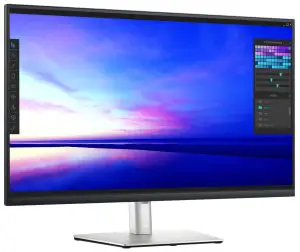
![]() NOTE: A NOTE indicates important information that helps you make better use of your computer.
NOTE: A NOTE indicates important information that helps you make better use of your computer.
Overview
Dell Display Manager is a Microsoft Windows application used to manage a display or a group of displays. It enables manual adjustment of the displayed image, assignment of automatic settings, energy management, window organization, image rotation, and other features on selected Dell displays. After installed, Dell Display Manager runs each time the system starts and places its icon in the notification tray. Information about displays connected to the system is available when hovering over the notification-tray icon.


![]()
![]()
![]()
![]()
![]()
![]()
![]()
![]()
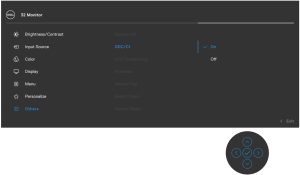

Using the Quick Settings Dialog
Clicking Dell Display Manager’s notification tray icon to open the Quick Settings dialog box. When more than one supported Dell displays are connected to the computer, a specific target display can be selected using the menu. The Quick Settings dialog box enables convenient adjustment of the display’s brightness, contrast, resolution, window layout, and so on. You can select Manual Mode or Auto Mode, and the screen resolution can be changed.


The Quick Settings dialog box also provides access to Dell Display Manager’s advanced user interface that is used to adjust basic functions, configure auto mode and access other features.
![]()
![]()
![]()
![]()
![]()
![]()
![]()
![]()
|
Feature |
Function |
Description |
| Quick DDM Access | Quick key to call up DDM UI |
|
| Control individual display in multiple display setup |
|
Setting Basic Display Functions
You can select Manual Mode that enables you to manually select a preset mode or select Auto Mode that applies a preset mode based on the active application. An on-screen message displays the current preset mode whenever it changes. The selected display’s Brightness and Contrast can also be directly adjusted from the Basic tab.
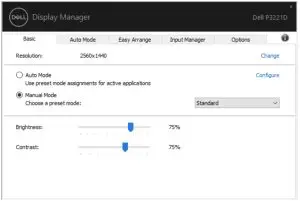

![]()
![]()
![]()
![]()
![]()
![]()
![]()
![]()
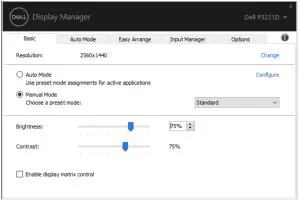

Assigning Preset Modes to Applications
The Auto Mode tab allows you to associate a specific Preset Mode with a specific application, and apply it automatically. When Auto Mode is enabled, Dell Display Manager automatically switches to the corresponding Preset Mode whenever the associated application is activated. The Preset Mode assigned to a particular application may be the same on each connected display, or it can vary from one display to another.
Dell Display Manager is pre-configured for many popular applications. To add a new application to the assignment list, simply drag the application from the desktop, Windows Start Menu, or elsewhere, and drop it onto the current list.
![]()
![]()
![]()
![]()
![]()
![]()
![]()
![]()
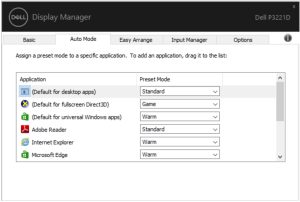

Organizing Windows with Easy Arrange
Easy Arrange helps you to effectively organize your application windows on the desktop. You first choose a pre-defined layout pattern which suits your work, then you just need to drag the application windows into the defined zones. Press “>” or use Page Up/Page Down key to find more layouts. To create a custom layout, arrange the open windows and then click Save.


For Windows 10, you can apply different window layouts for each of the virtual desktops.
If you often use Windows snap feature, you can select “Hold down the SHIFT key to enable zone positioning”. This gives Windows snap priority over Easy Arrange. You will then need to press the Shift key to use Easy Arrange positioning.


f you are using multiple displays in an array or matrix, Easy Arrange layout can be applied across to all the displays as one desktop. Select “Span multiple displays” to enable this feature. You need to align your displays properly to make it effective.


There are other advanced ways for the usage of Easy Arrange. Refer to table below.
|
Feature |
Function |
Description |
| Enhanced Easy Arrange | Custom layouts |
|
| 5 MRU (mostrecently-used) layouts | Press Ctrl+Shift+Home to cycle among the last 5 MRU layouts | |
| On the fly partition resizing |
|
|
| Easy Arrange layouts for portrait mode | Portrait mode Easy Arrange icons are presented when display is rotated. |
![]()
![]()
![]()
![]()
![]()
![]()
![]()
![]()
Managing Multiple Video Inputs
The Input Manager tab provides convenient ways for you to manage multiple video inputs connected to your Dell display. It makes it very easy to switch between inputs while you work with multiple computers.All video input ports available to your display are listed. You can give each input a name as you like. Please save your changes after editing.You can define a shortcut key to quickly switch to your favorite input and another shortcut key to quickly switch between two inputs if you often work between them.
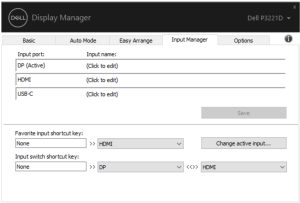

You can use the dropdown list to switch to any input source.


![]()
![]()
![]()
![]()
![]()
![]()
![]()
![]()
Restoring Application Positions
DDM can help you restore application windows into their positions when you reconnect your computer to the display(s). You can quickly access to this feature by right-clicking on DDM icon in the notification tray.
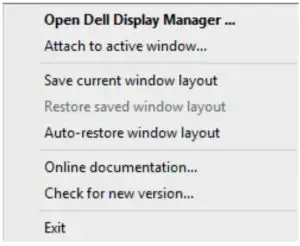

If you choose “Auto-restore window layout”, your application windows’ positions are tracked and remembered by DDM. DDM automatically puts the application windows into their original positions when you reconnect your computer to your display(s).
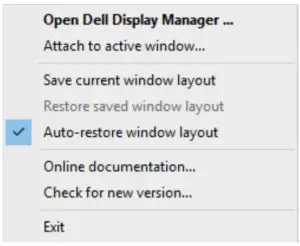

If you want to go back to a favorite layout after you have moved the application windows around, you can first “Save current window layout” and later “Restore saved window layout”.
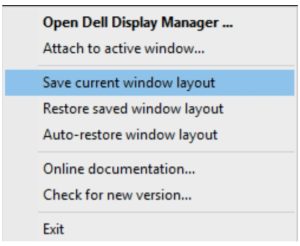

You may use displays with different models or resolutions in your daily routine, and you may apply different window layouts on them. DDM is able to know the display you have reconnected and restore application positions accordingly.
In case you need to replace a display in a display matrix configuration, you can save the window layout before replacement and restore the layout after a new display is installed.
NOTE: You should keep your applications running in order to benefit from this feature. DDM doesn’t launch applications.
Applying Energy Conservation Features
On supported Dell models, an Options tab is available that provides PowerNap energy conservation options. You can choose to set the display’s brightness to the minimum level, or to put the display to sleep when the screensaver is activated.
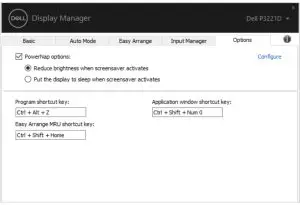

Other Shortcut Keys
Shortcut keys can be defined for below operations, you can define the shortcut keys for quick access to perform these operations:
- Program shortcut key: to quickly open the Quick Settings dialog box.
- Easy Arrange MRU shortcut key: to quickly apply the 5 recently used window layouts.
- Application window shortcut key: to launch a quick menu for options under Auto Mode and Easy Arrange

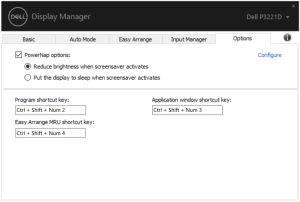
Attach DDM To Active Window (Only Windows 10)
DDM icon can be attached to the active window you are working on. Click on the icon for easy access to below features.
|
Feature |
Function |
Description |
| Attach DDM to Active Window (only Windows 10) | Change preset or snap to different partitions | DDM icon attached to active window and user can easily switch window position, change color preset mode, and associate auto preset mode. |
| Shortcut key trigger | On a running app window, press Ctrl+Shift+Ins also triggers the attached DDM menu. | |
| Move app window among Easy Arrange cells | Send the app window to previous/next Easy Arrange cell. | |
| Move app window among displays | Send the app window to previous/next display. |


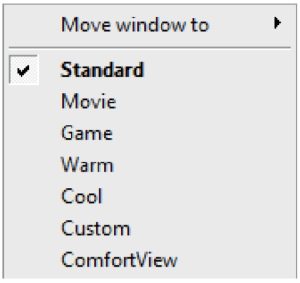

Troubleshooting
If DDM does not work with your display, DDM will show below icon in your notification tray.


Click on the icon, DDM shows a more detailed error message.
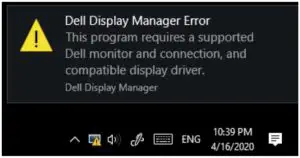

Please note that DDM only works with Dell branded displays. If you are using displays from other manufacturers, DDM doesn’t support them.
If DDM is unable to detect and/or communicate with a supported Dell display, please take below actions to troubleshoot:
- Make sure the video cable is properly connected to your display and your computer. especially the connectors should be firmly inserted into position.
- Check the display OSD to ensure DDC/CI is enabled.
- Make sure you have the correct and latest display driver from the graphics vendor (Intel, AMD, NVidia, etc.). Display driver is often the cause of DDM failure.
- Remove any docking stations or cable extenders or converters between the display and the graphics port. Some low-cost extenders, hubs or converters may not support DDC/CI properly and can fail DDM. Update the driver of such device if the latest version is available.
- Restart your computer.
DDM may not work with below displays:
- Dell display models earlier than year 2013 and D-series of Dell displays. For more information see www.dell.com/support/monitors.
- Gaming displays using Nvidia-based G-sync technology
- Virtual and wireless displays do not support DDC/CI
- Some early models of DP 1.2 displays, it may be necessary to disable MST/DP 1.2 using the display OSD
If your PC is connected to the Internet, you will be prompted to upgrade to a newer version of DDM when it is available. It is recommended to download and install the latest DDM application.
You may also check for new version by right clicking on DDM icon while pressing and holding ‘shift’ key.
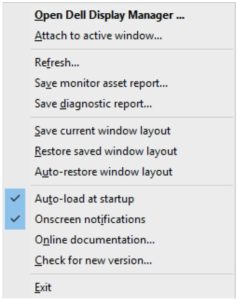



[xyz-ips snippet=”download-snippet”]

